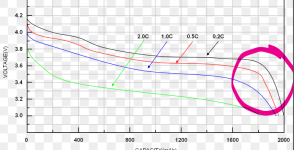mxlemming
100 kW
- Joined
- Jul 17, 2020
- Messages
- 1,120
I was out riding with a friend, we'd wired up 4x identical high discharge turnigy rapid 140C 4s2p rc packs to power his bike in 16s, I was using my usual 13s3p Samsung pack.
We started with the packs all equal, all charged to 4.1V... I have a photo of this actually since I'd WhatsApp'd him a pic to day "ready". We measured the while pack at 65.5V before setting out... Indicating 4.1V per cell.
Suddenly, half way through the ride, his bike lost 90%of power... Turns out 2/4 packs had dropped to virtually 0 (lowest was 600mV on a cell, typically they were at 1.7V). The other 2 packs had cells at 3.65V only about 1.5km before we'd stopped to measure the pack and had 59V implying 3.68 per cell.
Now I'm presuming they're wrecked... But... Wtf happened? How can that happen when they're all in series, and with such a big difference? Nearly half full on the other packs. And such a sudden crash.
If they'd shorted out there would have been signs like... Fire... But they were only mildly warm. And and cables all A-ok...
Any ideas?
We started with the packs all equal, all charged to 4.1V... I have a photo of this actually since I'd WhatsApp'd him a pic to day "ready". We measured the while pack at 65.5V before setting out... Indicating 4.1V per cell.
Suddenly, half way through the ride, his bike lost 90%of power... Turns out 2/4 packs had dropped to virtually 0 (lowest was 600mV on a cell, typically they were at 1.7V). The other 2 packs had cells at 3.65V only about 1.5km before we'd stopped to measure the pack and had 59V implying 3.68 per cell.
Now I'm presuming they're wrecked... But... Wtf happened? How can that happen when they're all in series, and with such a big difference? Nearly half full on the other packs. And such a sudden crash.
If they'd shorted out there would have been signs like... Fire... But they were only mildly warm. And and cables all A-ok...
Any ideas?


